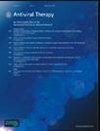Real-life findings on the impact of the COVID-19 pandemic on HIV care
IF 2.3
4区 医学
Q4 INFECTIOUS DISEASES
引用次数: 2
Abstract
The ongoing COVID-19 pandemic is rapidly reshaping the organization of healthcare systems worldwide, prompting the creation of COVID-19–dedicated wards and services at the expense of pre-existing structures. European countries are now facing the “second wave” of the COVID-19 epidemic, with increasing numbers of cases and deaths; hence, people with chronic conditions, including those living with HIV (PLWHIV), are struggling to maintain their routine disease management, resulting in missed medical visits and the risk of lower adherence to treatment. In our clinical center in Rome, Italy, we conducted a retrospective study aimed at observing how PLWHIV were followed-up during the “first wave” of the COVID-19 epidemic in the country and during the national lockdown from March 9 to May 28, 2020. We analyzed all treatment-experienced, virologically suppressed PLWHIV who had had at least one visit between March 10 and June 1, 2020, and collected viroimmunological parameters. We compared this group of PLWHIV with the patients observed over the same period in 2019. Our primary aim was to assess the rate of virological failures (VF, defined as two consecutive HIVRNA ≥ 50 copies/mL or a single HIV-RNA ≥ 1000 copies/mL). Predictors of VF were assessed using Cox regression analysis. Regarding the 2020 group, data from 341 patients were analyzed: 235 (68.9%) were males, with a median age of 54 years (Interquartile range = 46–60), a median time from HIV diagnosis of 16.1 years (IQR = 7.6–23.8), and a median time of virological suppression of 82.4 months (IQR = 31.1–142.9). With regard to antiretroviral therapy, 149 patients (43.7%) were on a 2NRTI+INI regimen, 74 (21.7%) were on 2NRTI+NNRTI, 70 (20.5%) were on a dual regimen with DTG+3 TC, 22 (6.5%) were on a regimen with 2NRTI+bPI, and 26 (7.6%) were on other regimens. Regarding the 2019 group, data from 1066 patients were available. All patients’ characteristics and differences between groups are shown in Table 1. During 184.3 Patient-Years of Follow-Up (PYFU) of the 2020 group, we observed 23 VF, a rate of 12.5 per 100 PYFU. In patients experiencing VF, we performed a genotypic test to investigate acquired mutations: among the 23 analyzed individuals, two of them, both on a 2NRTI+raltegravir (RAL) strategy, presented newly discovered mutations (one had both the 138K and the 148R mutations and the other had the 155H mutation) conferring resistance to RAL. Interestingly, patients on a dual regimen had significantly less probability of showing VF compared to patients on 3+ drug regimens: 6-month probability of remaining virologically suppressed was 98.8% vs 90.5%, respectively (log-rank p = 0.031). In the calendar period of 2019, we observed 50 VF during 675 PYFU, a rate of 7.4 per 100 PYFU. Time of virological suppression (aHR = 0.96 per month longer, 95%CI 0.95–0.98, p < 0.001) emerged as the only关于新冠肺炎大流行对艾滋病毒护理影响的现实调查结果
持续的新冠肺炎疫情正在迅速重塑全球医疗系统的组织,促使新冠肺炎——以牺牲原有结构为代价,建立专门的病房和服务。欧洲国家目前正面临新冠肺炎“第二波”疫情,病例和死亡人数不断增加;因此,慢性病患者,包括艾滋病毒感染者,正在努力维持他们的常规疾病管理,导致错过医疗就诊,并有降低治疗依从性的风险。在我们位于意大利罗马的临床中心,我们进行了一项回顾性研究,旨在观察PLWHIV在该国新冠肺炎“第一波”疫情期间以及2020年3月9日至5月28日全国封锁期间的随访情况。我们分析了所有在2020年3月10日至6月1日期间至少接受过一次治疗的病毒抑制PLWHIV,并收集了病毒免疫学参数。我们将这组PLWHIV与2019年同期观察到的患者进行了比较。我们的主要目的是评估病毒学失败率(VF,定义为两个连续的HIVRNA≥50拷贝/mL或单个HIVRNA≥1000拷贝/mL)。使用Cox回归分析评估VF的预测因素。关于2020组,对341名患者的数据进行了分析:235名(68.9%)为男性,中位年龄为54岁(四分位间距=46-30),从HIV诊断起的中位时间为16.1年(IQR=7.6–23.8),病毒学抑制的中位时间为82.4个月(IQR=31.1–142.9)。在抗逆转录病毒治疗方面,149名患者(43.7%)接受了2NRTI+INI方案,74例(21.7%)接受2NRTI+NNRTI治疗,70例(20.5%)接受DTG+3TC双重方案治疗,22例(6.5%)接受2NRI+bPI方案治疗,26例(7.6%)接受其他方案治疗。关于2019年组,有1066名患者的数据可用。所有患者的特征和组间差异如表1所示。在2020组的184.3患者随访年(PYFU)中,我们观察到23例VF,比率为每100例PYFU 12.5例。在经历VF的患者中,我们进行了基因型测试,以研究获得性突变:在23个分析的个体中,其中两个都采用2NRTI+拉替拉韦(RAL)策略,出现了新发现的对RAL具有耐药性的突变(一个同时具有138K和148R突变,另一个具有155H突变)。有趣的是,与3+药物方案的患者相比,双重方案的患者出现VF的概率显著降低:6个月内保持病毒学抑制的概率分别为98.8%和90.5%(log秩p=0.031)。在2019年的日历期内,我们在675 PYFU期间观察到50次VF,比率为7.4/100 PYFU。病毒学抑制时间(aHR=0.96每月更长,95%CI 0.95–0.98,p<0.001)是唯一的
本文章由计算机程序翻译,如有差异,请以英文原文为准。
求助全文
约1分钟内获得全文
求助全文
来源期刊

Antiviral Therapy
医学-病毒学
CiteScore
2.60
自引率
8.30%
发文量
35
审稿时长
4-8 weeks
期刊介绍:
Antiviral Therapy (an official publication of the International Society of Antiviral Research) is an international, peer-reviewed journal devoted to publishing articles on the clinical development and use of antiviral agents and vaccines, and the treatment of all viral diseases. Antiviral Therapy is one of the leading journals in virology and infectious diseases.
The journal is comprehensive, and publishes articles concerning all clinical aspects of antiviral therapy. It features editorials, original research papers, specially commissioned review articles, letters and book reviews. The journal is aimed at physicians and specialists interested in clinical and basic research.
 求助内容:
求助内容: 应助结果提醒方式:
应助结果提醒方式:


